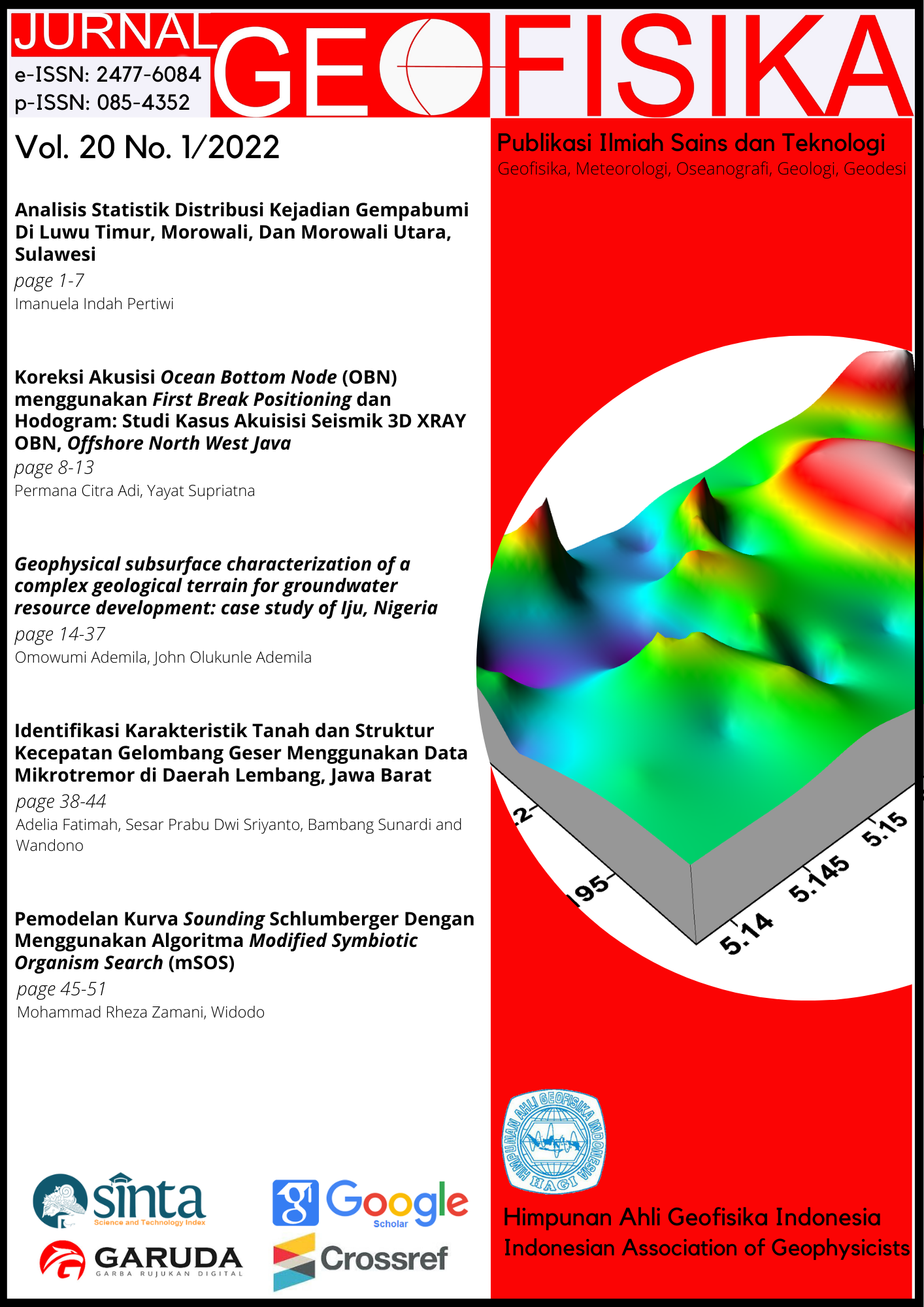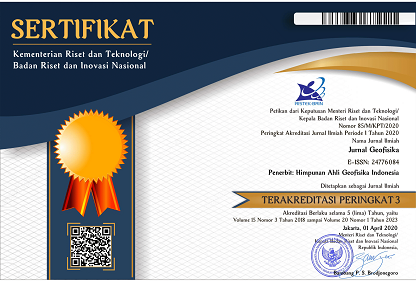Geophysical subsurface characterization of a complex geological terrain for groundwater resource development: case study of Iju, Nigeria
Keywords
Groundwater development, Electromagnetic investigation, Geoelectrical characteristics, Hydrogeological parameters, Aquifer characterization, Groundwater flow patternAbstract
Access to potable water facilitates rapid civilization, health and social stability in different regions of the world. Subsurface exploration involving detailed geological, geophysical; very low frequency electromagnetic (VLF-EM), electrical resistivity method using vertical electrical sounding (VES) techniques and hydrogeological survey was carried out to characterize the subsurface geological and hydrogeological conditions with a view to developing a contemporary groundwater resources scheme. This is to meet the demand for water and improve the lives of the residents in the study area. Groundwater flows from eastern, northeastern and northern directions to the central, northwestern, southeastern, southern and western parts of the area. Conductive zones within the subsurface established by the VLF-EM survey constitute the forty-seven (47) locations further investigated by VES techniques. Three to five geologic layers were identified, while the weathered and fractured bedrock form the aquifer units with depth in the range 3.5 to over 100 m. The fractured aquiferous unit represents the target aquifer due to its characteristic thick sandy geological formation (mean resistivity; 602 ± 140 Ohm-m) being more prolific in groundwater yielding capacity. Bedrock depressions with thick overburden (> 25 m) were identified as viable groundwater potential zones. Hydrogeological maps generated give insight into geological conditions of the aquiferous units. Groundwater potential map of the area categorizes aquiferous zones based on their yield potential. High groundwater yield potential zones of the area can be harnessed for massive groundwater development scheme. Other zones can be of use as the need arises.
References
Ademila, O., & Ololade, I. A. (2018). Geoelectrical imaging and physicochemical assessment of waste dumpsite: Implications on groundwater quality. Environmental Research, Engineering and Management, 74(3), 42- 54.
Ademila, O., & Saloko, B. (2018).
Hydroelectrical evaluation of groundwater flow pattern in supare akoko, nigeria. Environmental and Earth Sciences Research
Journal, 5(1), 7-14.
Keller, G. V., & Frischknecht, F. C. (1966). Electrical methods in geophysical prospecting. Oxford, UK: Pergamon Press Inc.
Koefoed, O. (1979). Geosounding principles, vol. 1. resistivity sounding measurements. Amsterdam, Netherlands: Elsevier Scientific Publishing Company.
Kr´asn`y, J. (1993). Classification of transmissivity magnitude and variation. Groundwater, 31(2), 230-236.
Loke, M. H. (2002, 01). Electrical imaging surveys for environmental and engineering studies: a practical guide
to 2-d and 3-d surveys.
McNeill, J. D. (1990). Use of electromagnetic methods for groundwater studies. In Geotechnical an environmental geophysics: Volume i: Review and tutorial (pp.
191–218). Society of Exploration Geophysicists.
Nabighian, M. N. (1988). Electromagnetic methods in applied geophysics: Voume 1, theory. Society of Exploration Geophysicists.
Offodile, M. (1983). The occurrence and exploitation of groundwater in nigeria basement complex. J Miner Geol, 20, 131–146.
Olayinka, A. (1992). Geophysical siting of boreholes in crystalline basement areas of africa. Journal of African Earth Sciences (and the Middle East), 14(2), 197–207.
Olayinka, A. (1996). Non uniqueness in the interpretation of bedrock resistivity from sounding curves and its hydrological implications. Water Resour. J. NAH ,
7(1&2), 55–60.
Olayinka, A., Akpan, E., & Magbagbeola, O. (1997). Geoelectric sounding for estimating aquifer potential in the crystalline basement area around shaki, southwest nigeria. Water Resources, 8(1), 2.
Olayinka, A., & Olorunfemi, M. (1992). Determination of geoelectric characteristics in okene area and implications for borehole siting. Journal of Mining and geology, 28(2), 403–411.
Olorunfemi, M., Olarewaju, V., & Alade, O. (1991). On the electrical anisotropy and groundwater yield in a basement complex area of sw nigeria. Journal of African Earth Sciences, 12(3), 467–472. doi:10.1016/0899- 5362(91)90138-O
Oluwafemi, O., & Oladunjoye, M. (2013). Integration of surface electrical and electromagnetic prospecting methods for mapping overburden structures in
akungba-akoko, southwestern nigeria. International Journal of Science and Technology, 2(1), 122–147.
Omosuyi, G., Adeyemo, A., & Adegoke, A. (2007). Investigation of groundwater prospect using electromagnetic
and geoelectric sounding at afunbiowo, near akure, southwestern nigeria. The pacific journal of science and technology, 8(2), 172–182.
Orellana, E., & Mooney, H. (1966). Master tables and curves for vertical electrical sounding over layered structures. Interciencia Madrid.
Patra, H. P., & Nath, S. K. (1999). Schlumberger geoelectric sounding in ground water- principles, interpretation and application. Rotterdam: Balkema Publishers.
Pirttijarvi, M. (2004). Kh filt program. a geophysical software for karous-hjelt and fraser filtering on geophysical vlf (very low frequency) data. Department of Geosciences, University of Oulu, Finland.
Rahaman, M. (1989). Review of the basement geology of southwestern nigeria. Geology of Nigeria. Elizabethan publishing Company Lagos, 41–58.
Sattar, G. S., Keramat, M., & Shahid, S. (2016). Deciphering transmissivity and hydraulic conductivity of the aquifer by vertical electrical sounding (ves) experiments in northwest bangladesh. Applied Water Science, 6(1), 35–45. doi: doi:10.1007/s13201-014-0203-9
Telford, W. M., Telford, W., Geldart, L., & Sheriff, R. E.(1990). Applied geophysics. Cambridge university press.
Todd, D. (1980). Ground water hydrology. Wiley. Vander Velpen, B. (2004). Winresist version 1.0 resistivity depth sounding interpretation software. M. Sc. Research Project, ITC, Delft Netherland.
Verma, R., Rao, M., & Rao, C. (1980). Resistivity investigations for ground water in metamorphic areas near dhanbad, india. Groundwater, 18(1), 46–55.
Vrbka, P., Ojo, O. J., & Gebhardt, H. (1999). Hydraulic characteristics of the maastrichtian sedimentary rocks of the southeastern bida basin, central nigeria. Journal
of African Earth Sciences, 29(4), 659–667.
Watson, K. A., & Barker, R. D. (1999). Differentiating anisotropy and lateral effects using azimuthal resistivity offset wenner soundings. Geophysics, 64(3), 739–
745.
Zohdy, A. A. (1965). The auxiliary point method of electrical sounding interpretation, and its relationship to the dar zarrouk parameters. Geophysics, 30(4), 644–660

This work is licensed under a Creative Commons Attribution 4.0 International License.
The copyright of all articles belongs to the authors. All other copyrights is held by the Journal











